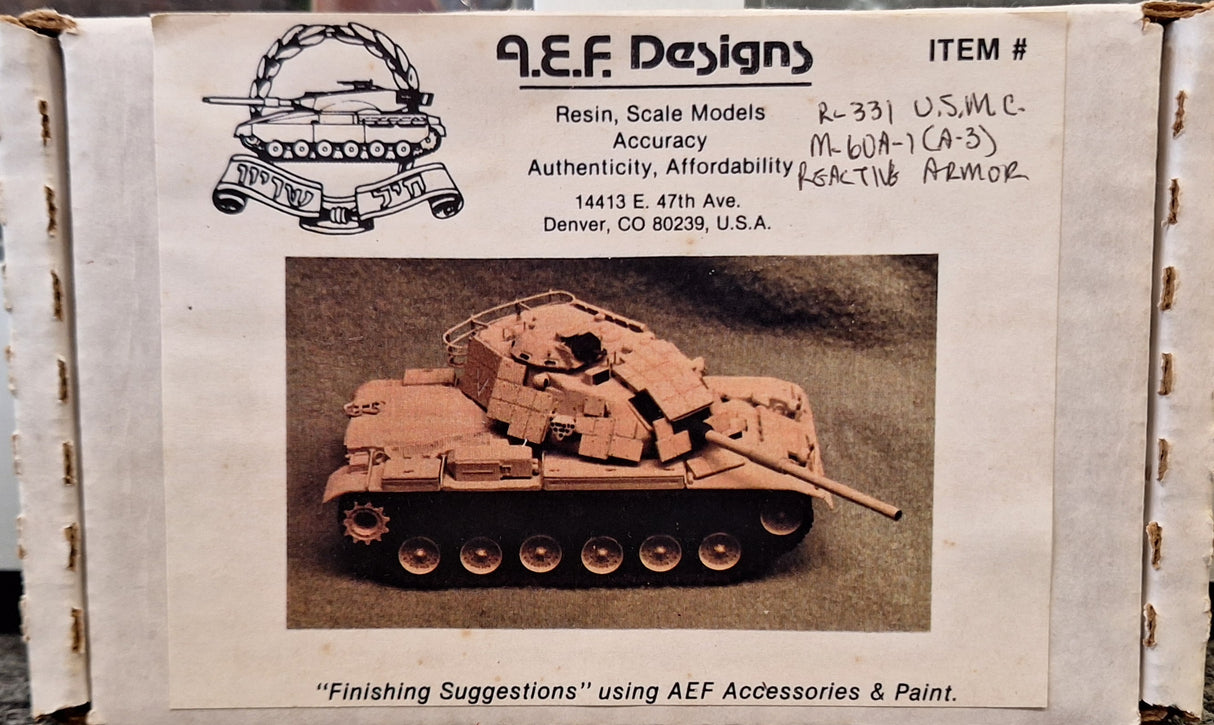AEF 1:35 USMC M60-A1 (A3) ERA Add-on Resin Kit
AEF 1:35 USMC M60-A1 (A3) ERA Add-on Resin Kit is backordered and will ship as soon as it is back in stock.
Couldn't load pickup availability
Delivery and Shipping
Delivery and Shipping
We use tracked courier for fast delivery New Zealand wide
Description
Description
AEF 1:35 USMC M60-A1 (A3) Explosive Reactive Armour (ERA) Add-on Resin Kit for 1:35 M60 Plastic Models. Resin kit, requires paints and glues to complete, not included.
Reactive armour is a type of vehicle armour used in protecting vehicles, especially modern tanks, against shaped charges and hardened kinetic energy penetrators. The most common type is explosive reactive armour (ERA), but variants include self-limiting explosive reactive armour (SLERA), non-energetic reactive armour (NERA), non-explosive reactive armour (NxRA), and electric armour. NERA and NxRA modules can withstand multiple hits, unlike ERA and SLERA.
When a shaped charge strikes the upper plate of the armour, it detonates the inner explosive, releasing blunt damage that the tank can absorb.
Reactive armour is intended to counteract anti-tank munitions that work by piercing the armour and then either killing the crew inside, disabling vital mechanical systems, or creating spalling that disables the crew—or all three.
The M60 Patton was an American 2nd generation Main Battle Tank. The first prototypes of the car were created in the late 1950s, and serial production continued in 1960-1987, ending with the production of over 15,000 copies of this tank. The M60 Patton was powered by an engine Continental AVDA-1790-2 with 750 hp. Armament in the basic version was a 105mm M68 tank gun, 1 12.7mm M85 machine gun and 1 7.62mm M73 machine gun.
Design work on The M60 Patton began as the American intelligence learned that the Soviet Army was going to introduce a new T-62 tank armed with a 115mm gun into the line. In an attempt to respond to this new threat, it was decided to deeply rebuild the M48 tank, creating a de facto new vehicle. First of all, new weapons were used, i.e. the 105mm gun, the armor was significantly strengthened and a new engine with more power was used. The new design was at least comparable to the T-54, T-55 or T-62 tanks, but was inferior to the T-64 and T-72 series vehicles, especially in terms of firepower. Three versions of the M60 were produced in the course of serial production. The first is the M60A1, which entered the line in 1969, had a new turret and even thicker armor. The M60A2 version with a 152mm cannon-launcher capable of firing guided missiles turned out to be a dead end. Finally, the last serial version is the M60A3, which had, above all, a modern fire control system (SKO) with a laser rangefinder and a passive night vision sight. M60 tanks of all versions have been exported to many countries, including: Brazil, Greece, Spain, Israel and Portugal. They also took part in many armed conflicts of the Cold War period, mainly in the Yom-Kippur war of 1973, the Iraqi-Iranian war of 1980-1988 and the war in the Persian Gulf of 1990-1991.
Payment & Security
Payment methods
Your payment information is processed securely. We do not store credit card details nor have access to your credit card information.




